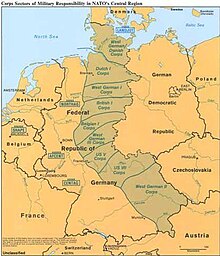NATO command structure
As NATO command structure ( NPS ; English NATO Command Structure ) refers to the integrated military command authorities of the NATO .
General
The command structure is under the political leadership at NATO headquarters in Brussels with the North Atlantic Council as the decisive body and the NATO Military Committee as the highest military body. The NCP is supplemented by the NATO Force Structure , which consists of the national armed forces of the member states and national or multinational headquarters at the tactical level.
history
Since the founding of NATO in 1949, the command structure has repeatedly been adapted to the military-political realities. During the Cold War , this consisted mainly of three command areas:
-
Allied Command Europe (English. Allied Command Europe , ACE), with
- Allied Forces North Europe (. English Allied Forces Northern Europe ; AFNORTH)
- Allied Forces Central Europe (. English Allied Forces Central Europe ; AFCENT)
- Allied Forces Southern Europe (. English Allied Forces South Europe ; AFSOUTH)
- Allied Command Atlantic (engl. Allied Command Atlantic ; ACLANT) and
- Allied Command Channel (. English Allied Command Channel ; Acchan).
Today's organization
It currently consists of headquarters on three levels. The highest level are the "Strategic Command" ( Strategic Commands ): the Allied Command Operations ( ACO ), and SHAPE in Casteau in Mons , Belgium, and Allied Command Transformation ( ACT ), formerly SACLANT in Norfolk , Virginia , USA .
ACO under the Supreme Allied Commander Europe ( SACEUR ) is responsible for the management of operations. ACT under the Supreme Allied Commander Transformation ( SACT ) is responsible for the transformation and permanent adaptation of the alliance to new requirements, the so-called transformation .
Allied Command Operations
At the second level are the ACO the following two "Operational commands" ( Operational Commands assumed):
- Joint Force Command Brunssum ( JFC Brunssum ) in Brunssum , the Netherlands,
- Joint Force Command Naples ( JFC Naples ) in Naples , Italy
- Joint Force Command Norfolk , ( JFC Norfolk ) in Norfolk , Virginia , USA, deployed July 26, 2019
The Joint Headquarters Lisbon ( JHC-Lisbon ) in Lisbon , Portugal was dissolved in December 2012.
The NATO Airborne Early Warning & Control Force Command ( NAEW & CFC ), which is stationed together with SHAPE in Casteau near Mons, Belgium, is also subordinate to SACEUR .
The operational commands, supported by commands from the armed forces, conduct operations such as SFOR , Operation Active Endeavor , KFOR (both in Naples) as well as ISAF and Air Policing Baltic States (Brunssum).
The tactical level consists of the Allied Air Command AIRCOM in Ramstein with two Combined Air Operations Centers (CAOCs) in Uedem , Germany and Torrejón , Spain and a Deployable Air Command and Control Center (DACCC) in Poggio Renatico , Italy. The Allied Air Command Izmir and the CAOC's in Finderup , Denmark and Larisa , Greece were dissolved.
As well as the command of the naval forces, the Allied Maritime Command MARCOM in Northwood (London) , the Allied Maritime Command Naples (Naples) was dissolved at the end of March 2013.
And since December 2012 the Allied Land Command LANDCOM in Izmir , Turkey. The previous land force commands in Heidelberg and Madrid were dissolved in April and June 2013.
In addition, the headquarters of rapidly deployable corps are available to ACO , including the Allied Command Europe Rapid Reaction Corps (ARRC). However, as national or multinational headquarters, these themselves do not belong to the NCP, but to the NATO armed forces structure.
Allied Command Transformation
ACT is subordinate to a number of training, testing and research facilities, including the Joint Warfare Center ( JWC ) in Stavanger , Norway, the Joint Force Training Center ( JFTC ) in Bydgoszcz , Poland, the Joint Analysis & Lessons Learned Center ( JALLC ) in Monsanto , Portugal, the Center for Maritime Research and Experimentation ( CMRE ) in La Spezia , Italy and the NATO school in Oberammergau .
organization chart
NATO command structure valid until 2013
Other departments
In addition to the Strategic Commands, NATO Headquarters reports directly to a number of other institutions, including the Canada-US Regional Planning Group ( CUSRPG ), the Combined Joint Planning Staff ( CJPS ) in Mons, Belgium and the NATO Defense College in Rome , Italy.
Web links
- Official website of NATO
- Official NATO organization charts
- New ACO organization
- New ACT organization
- Basic NATO documents (English)
- BBC: NATO tries to redefine itself (English)
- Permanent representation of the Federal Republic of Germany at the North Atlantic Pact Organization in Brussels
- Official site of the Allied Command Transformation
- NATO command structure according to the NATO manual ( Memento of November 13, 2010 in the Internet Archive ) (PDF file; 77 kB)


